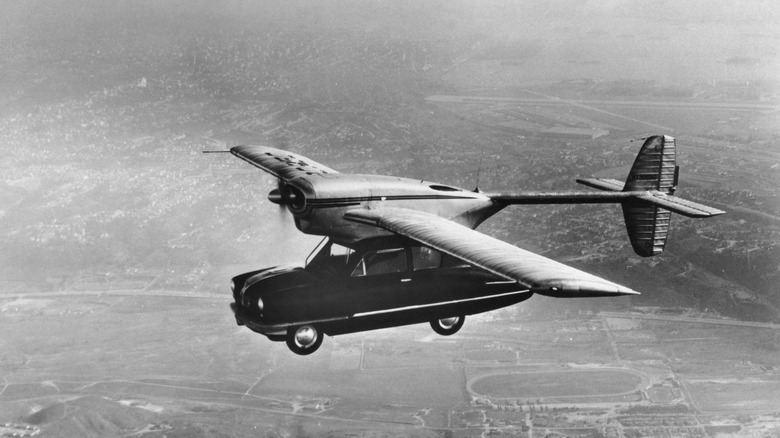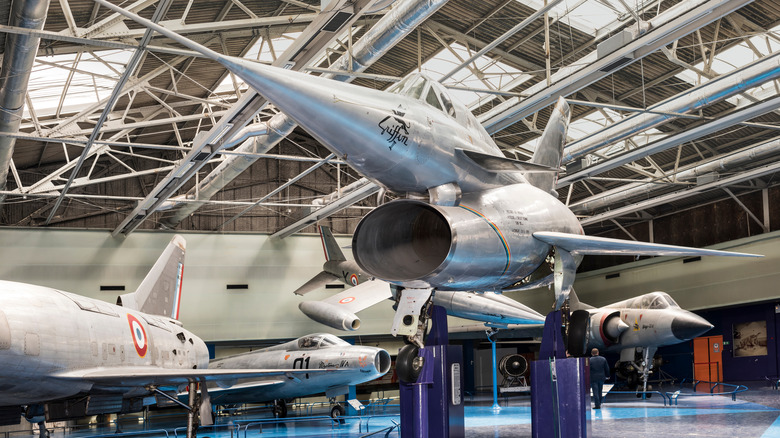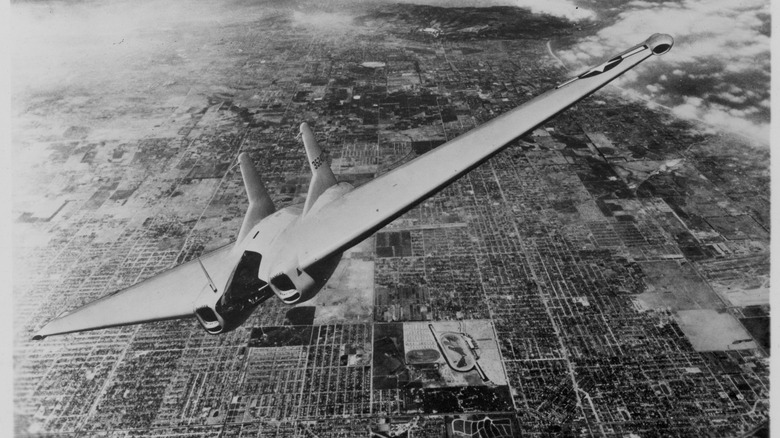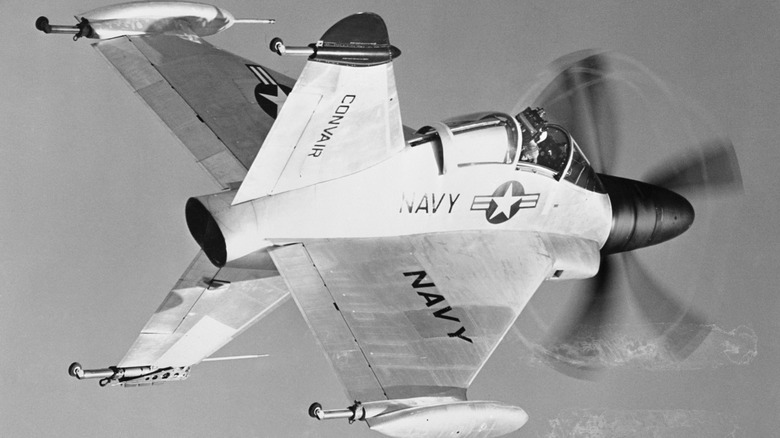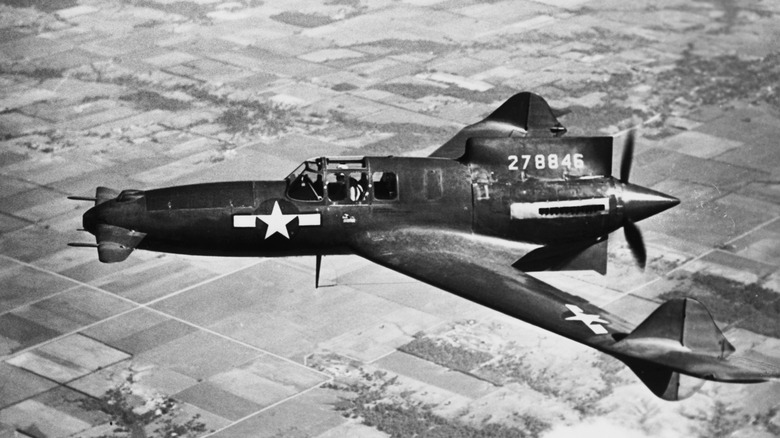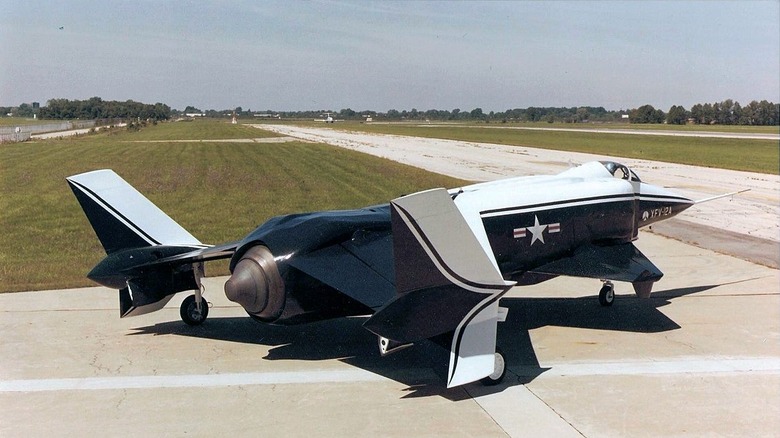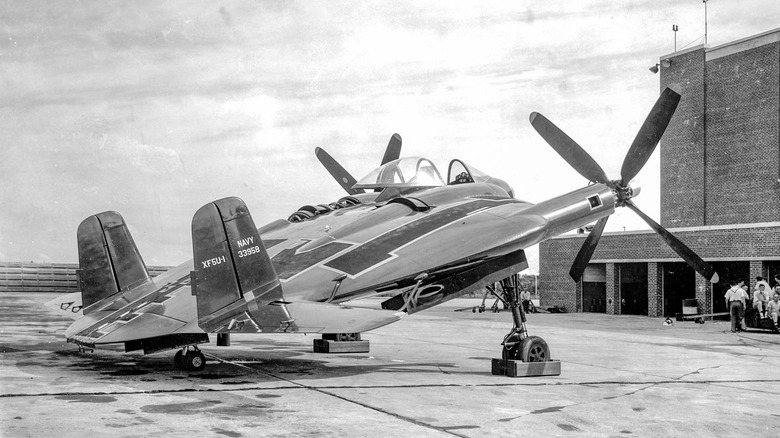6 Of The Strangest Fighter Jets Of All Time
When people generally think about fighter jets, they envision something sleek, easy on the eyes, and streamlined. The majority of modern fighter jets look relatively similar, with a few exceptions. Obviously, the F/A-18 Super Hornet and F-22 Raptor look nothing alike, but the Raptor and F-35 Lightning II definitely share some features in the looks department.
However, every once in a while, aircraft manufacturers decide to draw outside of the lines. Oftentimes these outlandish designs don't make it much further than the prototype phase — some don't even get off the ground for their first test flight — but they contribute a great deal to aviation development, nonetheless. It's important to know what doesn't work, after all.
Many of the weirdest-looking planes came about in the '40s and '50s following World War II, when air superiority became a significant priority. At the time, jet engines were relatively new and aircraft manufacturers didn't know which designs would be most efficient. Some Planes used a combination of prop and jet engines, while others utilized two types of turbojet engines, and some simply sported bizarre airframes.
Nord wrapped a cockpit around an engine with its 1500 Griffon
France spent a considerable amount of time rebuilding itself after World War II. Nord-Aviation spun out of this rebuilding phase with a focus on both missiles and planes. Nord's 1500 Griffon was built for speed, with the intention of using both a turbojet and ramjet to get itself off the ground. Even if you didn't know that, you could look at the Griffon and see that it's essentially a cockpit sitting on a giant engine. When Nord set out to test the plane's aerodynamics in 1955 with its maiden flight, it went faster than the speed of sound – Mach 1.3. And its production didn't stop there.
By 1959, the company shoved an Atar turbojet and one of Nord's own ramjets into it and got the updated Griffon II up to Mach 2.19 at an altitude of 50,000 feet. The pilot who flew this second prototype was none other than André Turcat, the first person to fly the supersonic Concorde passenger jet.
Unfortunately, the experimental jet suffered from overheating due to the fuselage being built out of inferior materials that didn't help regulate temperature at all. Pilots also had difficult time controlling it. Nord eventually dropped the project altogether without an operational model for the military ever making it to production. France instead focused on the Dassault Mirage III, which performed better and didn't cost as much.
Northrop's Flying Ram looked more like a flying manta ray
The Northrop name is venerated in the aeronautics field today, but it was still an infant in 1945, which could explain its unique vision for the XP-79. This plane had an unusual purpose no pilot had seen before: it was meant to take bombers out by crashing into them without suffering any damage itself. Thus, the nickname, the Flying Ram. Besides its unique objective, John K. Northrop, who designed the jet himself, included a few other unique features in the XP-79.
With the development of jet engines, Northrop believed that humans could withstand G forces better if pilots were laying horizontally, so he built the cockpit to accommodate it. It also became one of the first planes to use jet engines, equipped with twin Westinghouse 19B (J30) turbojets. It had no offensive weaponry to speak of, using only its reinforced fuselage to collide with enemy aircraft. It could reach a max speed of 525 mph and had a service ceiling of 40,000 feet. Unfortunately, the XP-79 didn't get much further in the production process than its maiden flight.
Test pilot Harry Crosby took it out on September 12, 1945 and got up to 10,000 feet before everything went wrong. When attempting a banking maneuver, the plane went into an uncontrolled spin and fell to the ground. Crosby didn't survive the crash and plans for the XP-79 were scrapped.
Dual propellors for Convair's VTOL XFY-1 Pogo
Militaries worldwide were studying the concept long before the legendary AV-8B Harrier II ever lifted off, and Convair's XFY Pogo is proof of that. This innovative jet was designed at the same time Rockwell was working on its XFV prototype. If there were a VTOL competition between the two experimental jets, Convair's would come out on top as it could successfully takeoff and land vertically. Not only that, it could also transition to horizontal flight and back to vertical.
The XFY-1 used the powerful Allison YT-40 turboprop engine, which pushed an impressive 5,850 shaft horsepower into two counter-rotating propellers.This jet could only takeoff and land from a vertical position, designed with intersecting wing-fins that prevented it from rolling up and down a runway. It wasn't without wheels, however. Each wing and fin was fitted with a small one at the end of a strut that would compress upon landing, slightly resembling a pogo stick.
Its first tethered flight took place in April 1954 with James F. "Skeets" Coleman, a lieutenant colonel in the Marine Reserve and a Convair engineering test pilot, in the cockpit. He got over 60 hours of tethered flight time in the XFY-1. It wasn't until August of the same year that he would take the jet out for some free flights. Unfortunately, issues like a failing gearbox and metal showing up in the oil started plaguing Convair's VTOL plane, and the Navy lost interest and pulled funding in 1956.
Curtiss-Wright went in the opposite direction with the XP-55 Ascender
A couple years before America and Japan went to war with each other in 1941, the U.S. Army Air Corps was experimenting with several new combat plane designs. Curtiss-Wright came up with a design that looked like nothing anyone had seen at the time. The cockpit was closer to the tail of the plane, the wings were swept back and positioned behind the engine, and even more peculiar, the propeller was on the tail. Combat planes at the time, such as the P-51 Mustang, had the props at the front, but Curtiss-Wright decided to stick a canard on the nose.
After a series of wind-tunnel tests and modifications — engineers added a vertical fin and rudder on each wingtip — the first XP-55 prototype was completed in July 1943. During a stall test, the pilot was forced to eject when he lost control of the plane and freefell for 16,000 feet. The second and third Ascenders flew in 1944, but after the third prototype crashed during an air show, Curtiss-Wright and the Army scrapped the project.
It wasn't so much that Curtiss-Wright was being unnecessarily risky — bucking norms in aviation design was what the Army had asked for. In a 1939 "Request for Data R-40C" document, the Army urged designers to "depart from accepted, low-risk, aircraft design practices and embrace radical new technology," according to the National Air and Space Museum.
Rockwell's XFV-12 couldn't get off the ground
After witnessing the splendor of the AV-8B Harrier, a fighter jet capable of vertical take off and landing (VTOL), the U.S. Navy wanted its own VTOL jet. It sponsored a competition for aerospace firms to present their own designs, which came down to Convair's Model 200 and a considerably less conventional submission from Rockwell International. At first glance, Rockwell's XFV-12 was a bizarre battle of different proportions, with front canards as well as wing-tipped fins and rudders.
However, there was some familiarity in the plane's design elements, too. Rockwell incorporated aspects of already existing successful fighter jets like the F-4 Phantom and A-4 Skyhawk. The air intakes, cockpit, and nose section were most recognizable. Additionally, it used the same Pratt & Whitney F401-PW-400 turbojet engine found in the F-15 Eagle.
Unlike the Harrier, which had vents pointed downward, the XFV-12 instead had its vents pointed directly at the underside of its wings to create lift. Rockwell called it a "thrust-augmented wing," and believed it would outperform the Harrier's VTOL capabilities. Unfortunately, tethered VTOL tests revealed otherwise, as the design couldn't deliver the necessary amount of lift to get the plane off the ground.
After pumping $1 billion into the XFV-12 project, the Navy pulled the plug in 1981, forcing both the Navy and Marine Corps to adopt the Harrier in 1985. It wouldn't be until the creation of the F-35 that the U.S. would get its own VTOL fighter jet.
The Vought XF5U-1 Flying Pancake resembled a flying saucer
If anyone in the '40s claimed to have seen a UFO or flying saucer, it could have easily been the "Flying Flapjack," otherwise known as XF5U. The Chance Vought Division of the United Aircraft Corporation started designing this disc-shaped blended wing and body prop plane in 1939. Lead designer Charles H. Zimmerman believed the shape would give the XF5U an even enough airflow to takeoff, fly, and land at lower speeds than other planes, and still perform well at high speeds. This was ideal for carrier-based operations. When Vought got a prototype to fly the first time in November 1942, the Navy was unsurprisingly interested.
Charles Lindbergh and multiple naval pilots tested the prototype, designated V-173, for a total of 131 hours, getting a good gauge of its strengths and weaknesses. Vought got to work on the larger design, which was going to be delivered to the Navy immediately. It would have been fitted with twin Pratt & Whitney R-2000-2(D) turbocharged radial engines, giving it a max airspeed of 363 mph at sea level and 482 mph at 30,700 feet. Zimmerman pushed the limits with the XF5U, as his goal was to give it a speed range of 40 to 460 miles per hour.
However, by the time 1945 strolled around, the Navy was already investing boat loads of money into several fighter jets using turbojet engines. It decided to scrap the Flying Pancake project by 1947.
